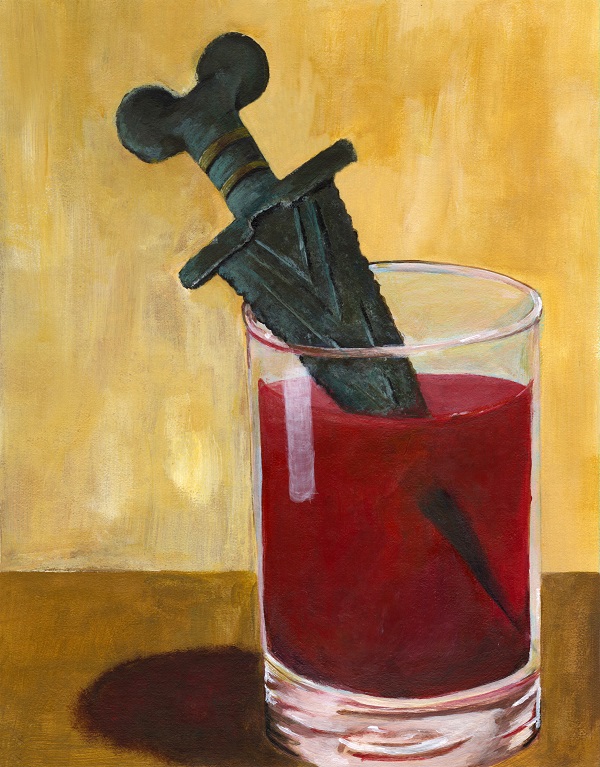Bloody Caesar (or The Ides of March)
Illustrated by Xuan Huong Phan
Rome’s flowing blood pulses through it’s veins.
Into the heart, out of it, into the heart, out into the fingers.
Thud thud. Thud thud.
Haemoglobin captures oxygen from the lungs, oxygen of the spring air. Blood cells shoot back and forth, get sucked into heart valves and blown out again into an arm, a leg, the nose, a foot. Cells carry carbon dioxide back from the extremities and into the lungs to be exhaled. The heart is relaxed and pushes the blood cells throughout the body, energizing the leg muscles that enable the organism to walk.
 The legs move in a different way, pinching the veins in the calf and heel. Slowly the organism descends stairs and the blood pumps faster. Up into the throat now, and into the head. The blood grows hot. The tongue wags. The oxygen of the Senate’s air enters the blood afresh to cool it, yet the temperature rises. The blood cannot smell the Senate air, but the organism knows where it is: in the heart of an Empire at its height.
The legs move in a different way, pinching the veins in the calf and heel. Slowly the organism descends stairs and the blood pumps faster. Up into the throat now, and into the head. The blood grows hot. The tongue wags. The oxygen of the Senate’s air enters the blood afresh to cool it, yet the temperature rises. The blood cannot smell the Senate air, but the organism knows where it is: in the heart of an Empire at its height.
Suddenly, the glands emit a torrent of adrenaline as the eyes dart to the side. The heart accelerates, until the rhythm mimics that of a galloping horse. Arms loosen and the legs run. Oxygen is blown into the muscles like a hurricane to incinerate glucose and produce energy. But the blood cells feed the muscles like water bearers attempting to fill a pond in the desert. A shadow hangs over the organism. The heart beats at its peak.
Thud thud thud thud.
Rippling sonic waves tear through the blood stream. Almost instantly, a full penetration as a pointed pugio slashes sinew. Hot blood pours from the neck and splashes on cold marble. Blood flows and the coagulation process begins, though there can be no hope to patch the wound.
The organism reels.
A thud in the back and marble stairs pinch the blood flow as the organism reclines. The arm moves forward to block the face as cells feed the gluttonous muscles. Another penetration. A stab. Blood snakes down the arm and wrists.
A ripple of waves ebbs the blood.
Further penetrations mutilate the chest, the shoulders, and the abdomen. Blood flows from veins and arteries until it becomes a scarce resource. A few seconds reprieve the wounds, but hold no consolation for the organism.
Another sonic wave moves through the blood. Once again, the cells hear nothing, but the ears hear everything. Et tu, Brute?
A pugio slips through the ribcage and kills the heart as the organism bleeds out.

Comments
Matthew
September 29, 2011Note from the author: to learn more about me, please visit my website Tales of an Author at
http://www.freewebs.com/matthewrettino. Thank you!
Kurt Caro
November 30, 2011Interestingly written piece of fiction. As a science student, I enjoy the details about blood circulation while keeping the description in an understandable way for others to enjoy as well. I very much liked the detailed and physical observations. It reminds me of Sir Arthur Conan Doyle’s work on his Sherlock Holmes series. Is there more to this piece of work? It feels as though I am reading a scientific report or analytical approach of an event mixed in with a strong sense of literature.
abouzo
November 30, 2011I enjoyed reading this creative piece of yours. As a sciende student, I have studied and learned about the heart and blood circulation. Reading and learning it from a detailed textbook is one thing, but reading it through the eyes of a creative writer is a whole other experience. I found it entertaining and enjoyed that you made it easy for all to understand as well. Were you making an analgous refernece to the heart as Ceacar, since we all know the heart is the driving machine of the body? An easy, fun and educative read. Great!
Kelly
December 2, 2011This was a really interesting read. You definitely chose a unique point of view. The way you described some of the veins made me dizzy. I think you were able to get a “timeline” across very well, especially since the story isn’t written through anyone’s sight or hearing. You established a beginning, (with the veins and blood flow running smoothly and regularly) a middle (the frantic pumping of blood, etc.) and an end (the ‘bleeding out’ of the body). Your final sentence worked well, but it may have been more uniform with the rest of the piece if you maintained the close proximity to the internal workings of the body, instead of ‘zooming out.’ Otherwise, very well done!
You have to be registered and logged in in order to post comments!